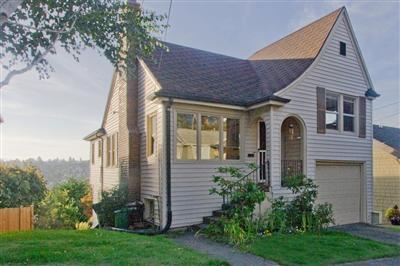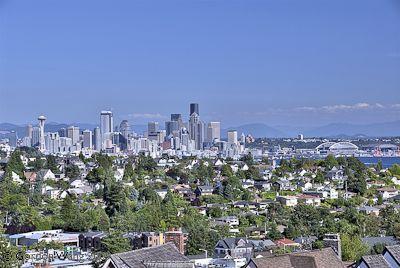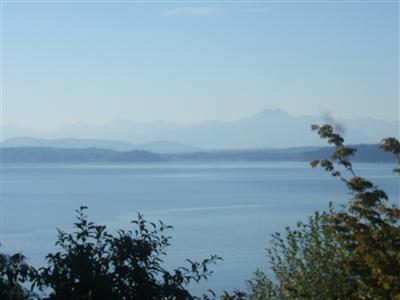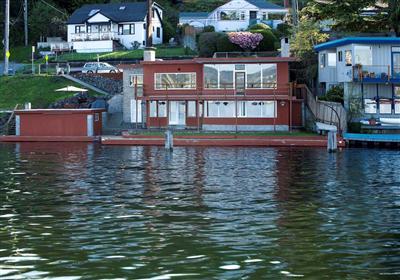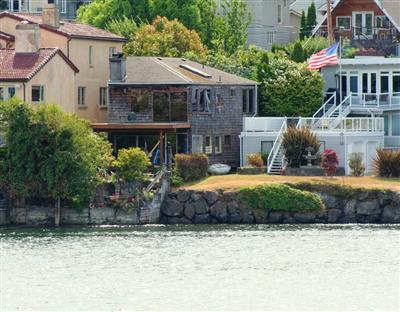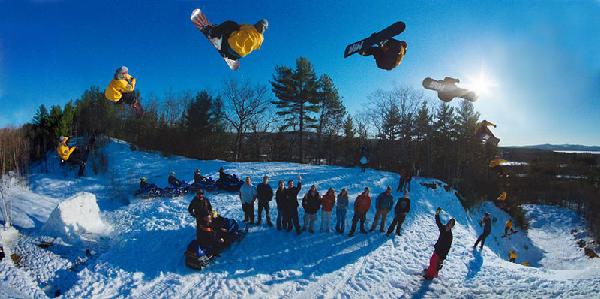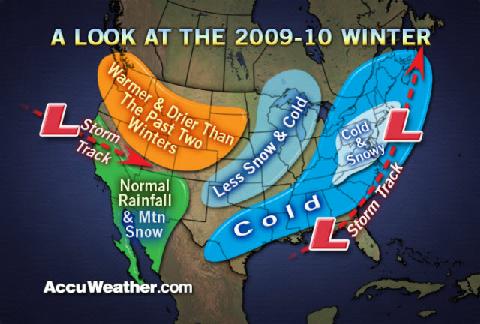| < | Wavepacket Blog only displaying 'predictions' posts |
> |
| << Newer entries << | |
| 2009 | |
| October | |
| Thu Oct 22 22:30:14 2009 The Dream Tour |
|
| Mon Oct 12 21:10:41 2009 The 2009-2010 Winter Forecast |
|
| September | |
| Thu Sep 10 23:24:51 2009 The Healthcare Debate |
|
| >> Older entries >> | |
| >> links >> | |
| Thu Oct 22 22:30:14 2009 The Dream Tour My guide to Seattle-area real estate. |
|||||||||||||||||||||||||||||||||
| Well, my own real estate journey is slowly coming to a close. Earlier this
year I decided to sell my home and buy a different one. I had three
motivations:
First, I wanted to move closer to downtown. Second, I think gas prices will climb dramatically again, so I wanted to be in an area where I could walk everywhere, even work. And third, the depressed housing market is an awesome time to trade up. My personal opinion is that most people didn't realize that. So I think I was able to save a lot more on my purchase than it cost me to sell in a down market. I put an offer in on a house in May, and put my own home up for sale in June. Only now in October have I finally got an offer on my house, and only now in October does it look like my May purchase could (maybe, hopefully) come through! So with a big dose of luck I'll close on both the sale and purchase in November. That means I've been watching the real estate market closely in Seattle for almost a year (I started looking well before I made an offer). I'm not a real estate agent or an expert! But I like looking at what's out there, and seeing what I think the deals are. So here is my own personal tour of Seattle's Best Properties. These aren't the prettiest homes, or the nicest inside. But these are the homes that I think have the most potential, and are the most underpriced. These aren't cheap homes, but they are either close to the median King County price, or are hugely discounted. WARNING: Although I have spent many days looking in and around homes in the greater Seattle area, I have seen very few of these particular homes in person. So take this as an overall tour of how I see the market through my own twisted lens, and not an endorsement of any one property. General PrinciplesFirst, I prefer homes that need some work. Sure, you have to do some work to improve them, but you get a discount on the purchase price. That means you may pay about the same price in the end, but you can have renovations done to your liking. And I don't even mean large renovations: many homes see significant improvement just by ripping out old carpets, removing funky fixtures such as accordian doors, and repainting. My last home had large security gates on some of the doors (but only some, thereby defeating the entire purpose of the security gates!). When we ripped them off, a friend said "Congratulations, you just added $5K to the value of your house."Second, the bones of the house should be solid. That is, you can put up with funky interiors and bad paint jobs, but poor foundations, settlement, or rot can be very expensive to fix. Stay away from those unless it's a real bargain. Third, look for good lots. I often see very nice homes on tiny lots, sandwiched next to each other with no privacy. Or I'll see nice homes on a very busy street with a lot of noise. Look for lots that have a balance of privacy and space, as well as accessibility. Those lots are out there! They don't even have to be large, they just have to be well laid out. Underappreciated View HomesThese are my personal favorite sort of properties. A protected view is rare, and therefore has the potential to appreciate more than other lots. An unloved home on a lot with a protected view could be worth much more in the long term than a beautiful home on a nondescript lot. But I find that homes that need work are really underpriced, so you can find great bargains in this category.Some of the properties I'd look at in this category: Here's one ( MLS listing 29143300) on Queen Anne with a good view to the west. I don't think this home is well marketed! The view photos are tilted (even more than the photos I take). You can see the house needs some updates, but if the bones are solid, then this is a steal at $499K. According to Zillow, this home is worth around $570K now. Zillow isn't very reliable, but that gives you an indication. Also, I like the lot for that property (check the Redfin listing link above). It's narrow, but long. That means there is a long slope which protects the view. This is a big house (3400 square feet), far too big for me. But if you needed the space, this is a good one. The lot is a good size for Seattle (5000 square feet) with front and back access. There is a bit of a slope, so that plus the street means the view is well protected. Zillow values this property at over $900K now, and valued it over $1 million in 2008. Again, Zillow isn't perfect. But it is an indication. And finally, there's this neglected gem in West Seattle. There could be a lot wrong with this one! But it is worth checking out. If the description is even close to accurate, this could be worth a lot more with some straightforward investment. Look at that lot! It's close to 11 thousand square feet (!), really protecting the view. Large single-floor homes are rare (this one is over 1900 square feet) and you could possibly add a second story if you wanted to. This definitely looks like the classic case of buying the most beat-up home in a neighborhood of very nice homes. Check out the nearby home values on Zillow! Again, that gives you an idea of the potential upside. This is worth significant remodeling and maybe even a rebuild. Underappreciated Waterfront HomesI've never owned waterfront. Partly because I don't know if I'd have time to truly enjoy boating. But mostly I've never owned waterfront because it is too expensive! But now there are waterfront properties in Seattle available at reasonable (non-stratospheric) prices.This property on the south end of Lake Washington is a good example of something to look for. It has a lot of deep waterfront for moorage. The layout of the house is good: the top floor is for entertainment and gathering (living, dining, kitchen) with three bedrooms on the cozy lower floor. It needs updating but the bones look solid. And it has it's own boathouse! If you are a rower you should really look at this one. In general, it has more privacy than many of its neighbors, and there is a lot of storage in and around the property. Worth a look! And there's this waterfront house, close to the Ballard locks. I think it is still fairly overpriced! The lot is small, as is the house (although not bad at over 1500 square feet). The property is laid out about as well as you could hope for a small narrow lot, and I really like the area by the water--it is pleasant access to the water from the house, and with minimal landscaping you could do a lot there. In general, it is much more private than its neighbors, which is remarkable given how close the houses are there. I think the price has a ways more to go, but I think it will start being attractive in the 650-700 range. Take a look at the values of nearby properties on Zillow. Again, that gives you an idea of the potential upside. Underappreciated NeighborhoodsWhat are the most prestigious neighborhoods in Seattle? I don't know, but I'd guess Capitol Hill, Fremont, and Queen Anne. Lately Ballard and West Seattle have gotten popular, and Magnolia, Wallingford, and Ravenna have cachet and appeal.But what are the neighborhoods that will be hot in 10-15 years? Buying in those now will probably result in bigger appreciation. I think one neglected neighborhood is Beacon Hill. It is close to the city, has views, and now also has Seattle's only underground lightrail station. It is very cool having convenient access to light rail! Here's an interesting listing on Beacon Hill. This is a home with eastern views, just a few blocks from the light rail station. It is perched on a hill, near a golf course. Of course, it also has very nice views, another reason that I like it. It has a very large lot (almost 9000 square feet!) with a reasonable layout. It may be priced a bit high, but I think Zillow's valuation of $479K is far too low. Zillow's algorithms break down when someone renovates a house, and I'm guessing that's what happened here. I think a price in the mid- to upper-500s would be a bargain. This is one of the more expensive homes in the neighborhood (which is also a bit of a risk), but it has clear value being such a large lot with a great view. Here's a cute house in Seward Park. I really like the layout of this property: you enter on the uphill side, and then enjoy the view on the downhill side. That tends to give you the most privacy. The house is slightly on the small side (1600 square feet), but it has had a lot of renovations. If the bones are solid, then something under $450K strikes me as a good price in an area that continues to be popular. Here's a house near where I live. This is kind of a cool neighborhood--nice older homes on a slope with a few distinctive streets cutting through. This is a good-sized house (2200 square feet) on a large lot (6100 square feet) with good views. One risk is the house to the east: that is a funky lot and someone could build bigger homes there. The biggest risk is the "Sold AS IS" tag in the description. It could be a perfectly nice bank-owned house that just needs interior updating! In which case, $350K is a ridiculous steal. Or it could have major structural problems, in which case you are really just paying for the land. Looking at the value of neighboring homes on Zillow you can see that there is real upside to the neighborhood! Farther OutOkay, so that's what $350-$750K buys you in Seattle. What if you are willing to go a bit farther out? Then a lot more options open up. I wanted to be close to downtown, so none of these were options for me. But sometimes I wonder...Okay, so Burien isn't exactly a hotspot... yet. But the little town has a lot going for it! It is near the airport but not in the main flight paths, and is accessible north to Seattle and south to Tacoma. And look again: this is Puget Sound waterfront for under $700K. That's pretty good! The house looks funky, but may be funky in a good way. Zillow values this house much lower, at closer to $550K, but that could be due to the renovations that have occurred since the last sale. But that does indicate you may have some room to bargain the price down a bit more. And if you're looking at Sound waterfront, how about Vashon Island? This property is probably overpriced at $699K, and it needs work. So you could probably make a much lower offer. It's possible that under $600K would get you a great waterfront location on Vashon, with views north and south, and over a half an acre of land. That would definitely be worth the necessary updates (and by the looks of it, you may need to add central heating...). And finally, look at this waterfront home on Vashon Island. At $425K, it is around the King County median sales price--and you can probably make a lower offer than that! Sure, it's small (1260 square feet), but it looks livable, and I like the layout of the waterfront grounds. It is probably a lot of work. The house needs updating. The exterior woodwork (docks and railings) probably need treating or replacing. But this is probably a good deal in the $400K range, if there aren't serious problems. Thanks... And finally, thanks to Redfin for such a great website! It definitely became my favorite, for its wealth of information and easy navigation. It was the only website to remember my searches reliably, and I loved the property overview and prior listing history. Comments |
Related: economics lists > predictions < Unrelated: books energy environment geopolitics mathematics science |
||||||||||||||||||||||||||||||||
| Mon Oct 12 21:10:41 2009 The 2009-2010 Winter Forecast How much snow will be in the Cascades this winter? |
|||||||||||||||||||||||||||||||||
| Should I buy a season pass to
Mt Baker this year?
Actually, I probably will. I haven't the past two years, and in each year it was almost worth buying one. I figure if I get a season's pass, I'll go a few more times, and then it will have paid for itself. But the bigger question is: is it stupid to buy a season's pass this year? After all, it is an El Nino winter, which typically means warmer, drier weather in the Pacific Northwest. And that means less snow. So for once, I decided to really research the 2009-2010 winter forecasts. What do the experts predict? Greg Simmon's forecast is dire: "a warmer and somewhat dry weather pattern is expected from the Pacific Northwest..." And he adds:
Well, shoot! I mean, I love hydro sources as much as the next guy, but we need snow! Then, Accuweather released a map of the expected precipitation (at left). Not good! The best resource is probably the National Weather Service, which has very detailed forecast temperature and precipitation maps for each month. The bottom line? We're screwed. Everyone predicts a dry winter. It might get better in April! So look for great spring skiing. Well, that's the prediction. How have they done the past few years? Here's the table I compiled. Mt Baker's average annual snowfall is 647 inches, according to their website. I figured a season was average if it was 600-700 inches of snowfall (which is a lot of snow, by the way...). Of course, as the Mt Baker ski area loves to tell you, they had the world record snowfall of 1140 inches in the 1998-1999 winter. That was the winter I learned to snowboard (not at Mt Baker, sadly), and I have to say: there was a crazy amount of snow that year.
So what does that say? It says that NOAA gets it right more often than a random guess (44% instead of 33%). But more scarily, the past two El Nino winters have been very dry. So, based on that, I'd guess this will be a very poor year, with less than 450 inches of snow! I say that because it has been incredibly dry so far this summer and fall. However, last year there was "only" 548 inches of snow, and I thought it was great. And hey: maybe this means that, during the 2009-2010 Winter Season at Mt Baker, every day will be like spring skiing! Comments |
Related: economics environment > predictions < Unrelated: books energy geopolitics lists mathematics science |
||||||||||||||||||||||||||||||||
| Thu Sep 10 23:24:51 2009 The Healthcare Debate The new proposals don't fix anything. |
|||||||||||||||||||||||||||||||||
| Of course, the
Great Healthcare Debate is all over the news now. Obama gave a
speech to Congress yesterday--check that out, it includes the heckling!--and there have been various healthcare proposals flying around.
[Random aside: did you read his Back to School speech? I thought it was excellent.] I wasn't sure what to make of the healthcare debate! I had to spend some time educating myself on the debate, and healthcare. I've had various small health care issues (bad ankle sprain last year, for instance) where I had to visit an Emergency Room and deal with complicated medical bills, but nothing like a prolonged stay in a hospital. I get healthcare insurance covered through my employer and rarely think about it. However, this is clearly a large debate with many things at stake:
I'm not a Democrat, but I'm not a Republican either. I'm an Independent who cares about healthcare (and no, I'm not going to any town hall meetings). I just wanted to understand the issues and see what I thought should be done. I had many questions myself. Why exactly is our healthcare system broken? Many people claim it is broken, and they all have their own solutions to sell, but what exactly is broken about it? Also, What is the Democratic solution? How is it going to fix the problems? And finally, Why is the solution so complicated? I remember everyone complaining that No one had actually read the healthcare bill, why didn't they? What I discovered was:
To put it succinctly, I was disappointed! I was hoping someone might fix something. I don't think improving healthcare access is bad, but this isn't really a fix. My guess (and prediction) is that a version of this healthcare bill will pass. We'll spend a bit more to increase coverage, and try to find ways to pay for it. I doubt we'll be entirely successful at that, but increasing coverage may be worth spending more money. However, I do wish someone would actually fix the system. This isn't tweaking, or addressing fraud, but really going back to basics and rebuilding the system right. First of all, the fix shouldn't start with a complicated 1000 page document. Instead, there should be a simple statement of principles that fits on one page. Then we could look at the principles and decide if they were right or not. If they were, we could tell Congress: "go and implement a healthcare solution that follows these principles." So what would those principles be? Lately, I read a great article about the healthcare system by David Goldhill in The Atlantic Monthly. The author gave a good overview of what was wrong, and his points on how to fix it. You may disagree! But I thought he had a great starting point for principles to really fix the system. Here are Goldhill's principles:
The number one complaint to the Goldhill approach (having us pay for almost all expenses ourselves) is that it would be too expensive. However, we are paying those costs today! It's just hidden. If you are lucky enough to be employed, a huge chunk of money is being paid for your healthcare by your employer. (If you aren't lucky enough to be employed, your government healthcare payments are coming from the paychecks of those that are working--the government doesn't create wealth, after all, it just moves it around). You don't see it, but it's money that is being paid and can only be used for healthcare. Under the Goldhill plan, you would get that money and be able to save it yourself. And you could spend it on other things besides healthcare if you wanted to! Goldhill's article gives a good argument for why this might work. I like how his plan gets medical costs and bills to be very transparent, lets consumers decide what to do, and naturally forces hospitals and healthcare providers to lower costs while improving care. And the general idea, that comprehensive health insurance is a poor way to cover most healthcare expenses, is key. I don't know enough to say if Goldhill's plan is the best or not. But I like how it fixes (or attempts to address) the core economics of the issue, rather than trying to patch or extend something that is already broken. If nothing else, ask your Congressional representatives to provide you with a clear, short list of the principles they will use to reform health care! Comments |
Related: economics > predictions < Unrelated: books energy environment geopolitics lists mathematics science |
||||||||||||||||||||||||||||||||
| Links: |  |
Blog Directory | Blog Blog | Technorati Profile | Strange Attractor |

